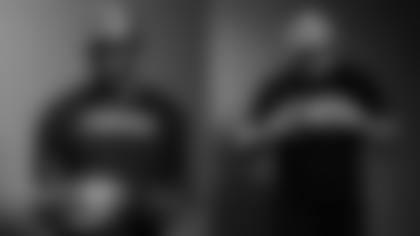The quest to design the Bengals' new uniforms, a two-and-a-half-year journey that ends with Monday's unveiling, began at the top.
Team founder Paul Brown's iconic black striped helmet, still relevant and riveting 40 years later, has ushered in the next generation of football fashion.
"It's the most recognizable helmet in the NFL. Why change it because you're changing jerseys?" asks Bengals equipment manager Adam Knollman. "Make the jersey match the helmet. Make the uniform flow with the helmet."
Or, as Monty Montague, the Bengals merchandise manager observes, when a tweak to the helmet was suggested early in the project the team pushed back because, "You can always tweak the current just for the sake of doing it, but it just didn't tie into what we wanted to accomplish with the jerseys."
What the Bengals accomplished won't be known until Monday, but how they did it is the product of an intense 30-month process of give-and-take with NIKE and the NFL that began when Bengals quarterback Joe Burrow was projected as a last-day draft pick and head coach Zac Taylor was coaching the Rams quarterbacks when the starter was Jared Goff.
It turns out that NFL stands for Not For Long in everything but changing uniforms.
"People think when you get a new quarterback or a new coach, you can just turn on a switch and you can have new uniforms," Knollman says. "It just doesn't happen like that."
The key words emerging from the effort are "classic." "Sleeker." "Simpler." When the Bengals began the re-design, they were asked to put their vision into words and they got a fortuitous turn when they hired Elizabeth Blackburn as the team's director of strategy and engagement as the project headed into its final critical phase about a year ago.
One of Blackburn's charges has been to develop a coherent and consistent brand of internal philosophy and external messaging based on innovation and modernity. They are confident the first new uniforms in 17 years bring that to life.
"That's what the uniform does. The uniform should tie in with the vision and where this team is going," Blackburn says. "We designed it in a way for it to be around a long time and be recognizable like our helmet. Ultimately it's timeless. They're new and modern, but it has all the elements that tie into our founding and all the characteristics that made P.B. so excellent and great. We want the new uniform to embody that and carry us forward for a long time."
When Montague raised the possibility of new uniforms during one of his post-game meetings with ownership somewhere in the middle of the 2018 season, it was far from the first time executive vice president Katie Blackburn and her group had studied the issue.
"My mother has gone through evaluations several times," Elizabeth Blackburn says. "It takes years to complete."
Montague wryly admits, "I listen to sports talk radio probably too much and I'm on Twitter, unfortunately," and so he knew, as did everyone else at the meeting, that the fans were restless. In his research, Montague noted that the wildly popular uniforms of the early 1980s lasted for 16 years into the mid-1990s. In 2018, the 2004 uniforms were approaching the same landmark.
"The look in the early 2000s was great, but styles change," Montague says.
A group was formed to begin the push, consisting of ownership, vice president and chief marketing officer Brian Sells, Montague and Knollman.
Knollman, heading into his 14th season running the equipment room, knew the players were also ready for a change. "They see what other teams are wearing." His first year around the team had been 2005 and he saw how the 2004 re-design remained popular for years.
But …
"It was time," says Knollman, who passed on the players' likes and dislikes.
That meant putting their thoughts on paper for NIKE and the NFL. And that meant not only communicating what they wanted the new uniform to look like, but what they wanted the brand convey. Plus, Montague put his Twitter skills to use with polls to rank fan favorites for jersey silhouettes and colors in order to find the right mix of color jerseys.
It took about a year for the words to jump off the page into design through trial and error. For a while, some didn't think it would ever leave the paper.
"Some of the early renderings weren't what we wanted. They were pretty far off," Knollman says. "You were kind of questioning if they were reading what we wrote. Personally, I felt like what we had was better. Then there was some back and forth and we started to make tweaks and I think the final product is what the group envisioned from the start. It's a good look."
Montague figures by the end of 2019 and the start of 2020, the design began to take off. When Elizabeth Blackburn joined the Bengals in February of 2020, she helped sharpen and unify the message as the project transitioned from evolving to nit-picking. At some point it reached the TV stage, where the NFL made sure the numbers and names could be seen from a certain distance. They passed the (camera) eye test.
The opt-out date was somewhere in the late spring of 2020, but they were rolling to the 2021 opener with a fresh new No. 9 for a fresh new franchise quarterback.
"You could probably say we've been nit-picking for a year. But there's also been a lot to do in that time," Montague says.
In the last year there is a mountain of paperwork with thousands of orders. Production isn't around the corner it's overseas. Montague had to have a crystal ball of sorts to get the right five jerseys for next week's Pro Shop debut from a roster undergoing massive change since that 2018 meeting.
Back in September they opted to order Burrow's No. 9, running back Joe Mixon's No. 28, wide receiver Tyler Boyd's No. 83, Tee Higgins' No. 85 and defensive end Sam Hubbard's No. 94.
No brainers, really. Burrow is Burrow. Hubbard is a hometown product and one of their best defenders. Mixon and Boyd both have a pair of 1,000-yard seasons. Higgins, a rookie, was the only real gamble back in September. But was he really?
"A lot of people thought he was a first-rounder," Montague says. "We felt good about that."
This is how long it took. When the process began, Burrow was easing in as the starter at LSU, Higgins was a sophomore at Clemson, Mixon and Boyd had yet to have a 1,000-yard season and Hubbard was a rookie.
As last season unfolded, they ordered the No. 30 of free safety Jessie Bates III and No. 24 of Vonn Bell and plan to have them in the Pro Shop in September.
"We've got an eye on that No. 5 pick. There are some pretty well-known names," Montague says. "We should be able to get them in sooner rather than later."
After 30 months ranging from conceptualizing eras to nit-picking fonts, Montague isn't giving up any hints of Monday's show.
Only this.
"Clean," Montague says, 'never goes out of fashion."







